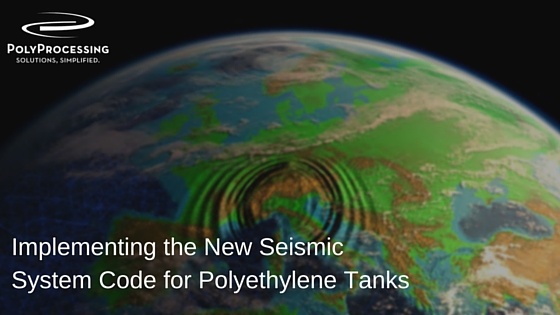Implementing the New Seismic Systems for Polyethylene Tanks
 (This post on seismic code works off of the 2015 IBC, which is the latest, most up-to-date standard. The UBC has been replaced by the IBC and is no longer updated.)
(This post on seismic code works off of the 2015 IBC, which is the latest, most up-to-date standard. The UBC has been replaced by the IBC and is no longer updated.)
Seismic codes are building codes that pertain to earthquakes and govern structural design and other preventative measures. Any builder in a seismically active region, including everywhere along the Pacific Rim, needs to pay careful attention to the safety measures established in this building code. While buildings and plants obviously require specific seismic codes, so too do your chemical storage tanks.
The recent updates to seismic code mean there are corresponding changes to how tanks are secured.
Tanks and Self-supporting Structures
There can be confusion as to which parts of the code end users, engineers, and contractors should focus on. As it pertains to storage tanks, the requirements in the ASCE in chapter 15 should be adhered to, and not chapter 13, which mentions vessels supported by a building. Essentially, the difference has to do with whether the tank is self-supporting or not.
To find the specific seismic code that relates to chemical storage tanks, refer to the 2015 IBC and the American Society of Civil Engineers (ASCE) 7-10, chapter 15.7, which covers “tanks and vessels that are supported within buildings.” This refers to any self-supporting structures that carry gravity loads and resist the forces of earthquakes or other seismic activity.
Changes to 2015 IBC
The updates to the latest specifications are relatively minor in comparison to the 2012 release. The new changes focus mostly on tougher concrete requirements, as well as the need for greater ductility in clips needed to better absorb the forces of seismic events. There are also changes when it comes to wind speeds, which have been raised in several areas, particularly in Florida.
While there are changes in the current code, it’s not quite as massive as the update from 2009 to 2012. It is significant, though, and it will be the prevailing code for plants nationwide starting January 1, 2017. Updated requirements only apply to new tanks built after the code goes into effect.
Poly Processing and Seismic Calculations
Poly Processing has built a calculation system to handle seismic code issues whether you need a wet stamp, or calculations for a permit, or you simply need data for budgeting or planning . Calculations are address specific so an end use address is necessary for us to provide you with the correct calculations.
Poly Processing has long-standing relationships with reliable third-party engineers for more than 25 years to ensure quality tank restraint systems are done correctly per state code. A qualified third party engineer provides the design and certification stamps of all Poly Processing tanks requiring a restraint system. Even in areas of the United States with minimal seismic or wind activity, we typically see specifications for restraints. We’ve created systems for almost every type of tank that we offer, whether that be a vertical tank, cone-bottom tank, or even a double walled tank. Each seismic calculation is site specific, so it’s important that you have a company working for you who is reliable in every region.
Proper seismic and wind restraints are a key component in operating a safe, long-lasting chemical storage system. The third-party engineer ensures that the design meets the current IBC requirements to give the end user peace of mind. The third-party engineer also backs the restraint system calculations and handles any questions with the IBC reviewer.
Contact us to learn about how we can help answer your questions regarding seismic system calculations.
- February 17, 2016
- Topics: Fittings and Accessories
About Poly Processing
Posts By Topic
Tech Talk Podcast Episodes
Subscribe By Email
Recent Posts
- Protect Your Facility and Your Bottom Line with a Chemical Leak Detection System
- PPC Installation, Operation, and Maintenance Manual: Ensure Tank Longevity
- How To Use The Chemical Resistance Guide
- Better and Safer Alternatives to Downpipes
- Crosslinked Polyethylene Vs. Fiberglass Reinforced Plastic Tanks
Tank Configurator

Find the recommended tank and system components for your chemical storage challenge.
Configure a Tank Package


